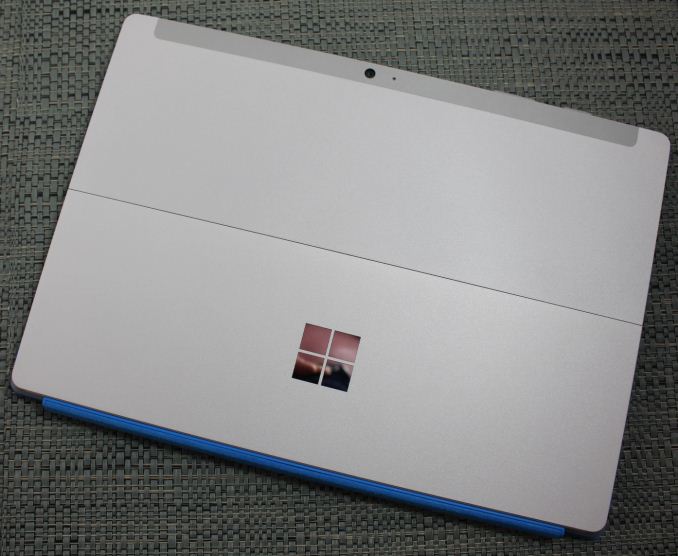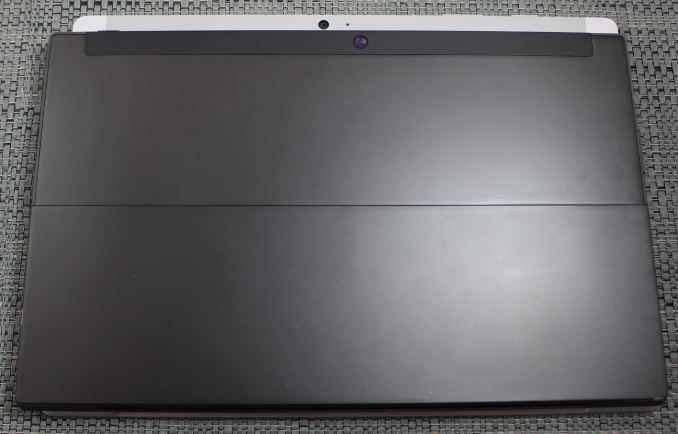The Surface 3 Review
by Brett Howse on May 4, 2015 9:00 AM EST
The Surface lineup for Microsoft has been extremely interesting to watch. What first launched in October 2012 as the Surface RT has been constantly iterated upon, and of course the Surface Pro line has evolved even faster. Surface Pro 3 has finally provided Microsoft with something that critics and consumers alike seem to have bought in to, and sales have been very strong since the Pro 3 was launched on May 20th 2014. However there has always been questions about the “consumer” version of Surface. Surface RT was, frankly, a sales disaster. The much improved Surface 2 fixed many of its shortcomings, but certainly did not set the world on fire. So now we have the third generation Surface, aptly named the Surface 3. There are a pile of changes that Microsoft has made to this generation of device, and obviously their hopes are that Surface 3 will be as popular as the Surface Pro 3 has been, but extending the device back down to a lower price point.
That price point is important. As much as the Surface Pro 3 has gained its share of fans, it is far from cheap. The most inexpensive model starts at $799, and for that you still do not get the keyboard. Surface 3 moves that bar down significantly, and the starting price is the exact same as the original Surface RT, at $499. Microsoft had to trim down the Pro model to hit this price point, but the cuts were well placed.
 Surface RT compared to Surface 3
Surface RT compared to Surface 3
I think looking at the Surface 3 in a vacuum would be improper, since the device now is really an evolution of the previous two Surface models. From a build quality standpoint, the original Surface RT was top notch, with its VaporMg case, the revolutionary kickstand, and high attention to detail for all of the aspects from buttons to display. I think in 2015 it is pretty obvious what the shortcomings of the Surface RT were though. Performance was less than acceptable with the Tegra 3 SoC on board, and Surface RT was handicapped with the confusingly named Windows RT operating system and the lack of software compatibility that goes with using an ARM CPU instead of traditional x86. Surface 2 fixed the performance issue by moving to NVIDIA’s Tegra 4 SoC, and while not the outright fastest tablet chip, it was at least in the ballpark. However it kept the Windows RT operating system at a time when everyone else had abandoned it.
Surface 3 has fixed that final issue and at the same time made some amazing improvements to the overall design and feel. Full x86 Windows is on tap, for better or for worse, and powered by a brand new SoC. This must be a special moment in history where a Microsoft built device is the launch vehicle for a brand new product from Intel. The Surface 3 is powered by the 14nm Intel Atom x7, in this case the x7-Z8700 model which is the current top of the line Atom processor. Codenamed Cherry Trail, this is the massaged Bay Trail cores now built on Intel’s now mature 14nm FinFET process, and they include the same GPU cores as Broadwell.
| Microsoft Surface Comparison | |||
| Surface 3 (Base) | Surface 3 (High) | Surface 2 | |
| Size | 10.52 x 7.36 x 0.34 inch 267 x 187 x 8.7 mm |
10.81 x 6.79 x 0.35 inch 275 x 173 x 8.8 mm |
|
| Weight | 1.37 lbs - 622 g | 1.49 lbs - 675 g | |
| Display | 10.8-inch ClearType Full HD Plus 1920x1280 resolution, 3:2 ratio 10-point multi-touch Surface Pen Support |
10.6-inch ClearType Full HD 1920 x 1080 resolution, 16:9 ratio 5-point multi-touch |
|
| Battery | 28 Wh, 13 W AC Adapter | 31.5 Wh, 24 W AC Adapter | |
| Storage | 64GB | 128GB | 32GB or 64GB eMMC |
| RAM | 2GB | 4GB | 2GB |
| CPU | Atom x7-Z8700 Quad Core 14nm 1.6 GHz Base Frequency 2.4 GHz Burst Frequency |
NVIDIA Tegra 4 4x ARM Cortex-A15 @1.7GHz |
|
| WiFi | Marvell 802.11ac + BT 4.0 LTE Models at a later date |
802.11n + BT 4.0 | |
| Ports | USB 3.0, Mini-DisplayPort, microSD, Micro USB charging, 3.5mm Headset Jack |
USB 3.0, micro-HDMI, microSD, proprietary charging | |
| Software | Windows 8.1 Office 365 Personal with 1TB OneDrive (1-year) |
Windows RT 8.1 Office 2013 RT Home & Student Edition |
|
| Front Camera | 3.5 MP | 3.5 MP | |
| Rear Camera | 8.0 MP with Autofocus | 5.0 MP | |
| Operating System | Windows 8.1 64-bit | Windows RT 8.1 | |
| Warranty | 1-year limited | 1-year limited | |
| Price | $499 | $599 | $449 |
In addition to the new SoC, Surface 3 can be purchased with up to 128 GB of eMMC storage, and the higher storage models also come with 4 GB of RAM. This compares to the base model which is 2 GB of RAM and 64 GB of storage, which is already one of the big improvements Microsoft has made with Surface. 32 GB of storage on a Windows tablet is really the bare minimum required, and the move to 64 GB as the base is going to make this tablet far more usable. You can of course add more storage with a micro SD card, but until Windows gets the great SD card support from Windows Phone, it still means that you need to manage your storage more than you should have to.
There are so many changes with the Surface 3 that really, this is likely the Surface that most people wanted from day one, but did not know it. First up is the new (again) kickstand.










265 Comments
View All Comments
RafaelHerschel - Tuesday, May 5, 2015 - link
That is a weird statement. Whose fault is it then? You're right about one thing though, AMD is woefully behind Intel. I wish it wasn't so, but I don't see AMD making any real progress soon.At this point efficiency is king and Intel with their 'mobile first' philosophy is now becoming a viable alternative for the mobile market. Sadly I don't think that AMD has the budget to compete.
lilmoe - Thursday, May 7, 2015 - link
If we're talking efficiency, then ARM is king IMHO. The upcoming custom ARMv8 designs should give Intel a run for their money. AMD's Zen cores were developed with mobile first in mind with supposed great single threaded performance. It'll be interesting to see how things fold out. Too bad we'll have to wait a year at least for that.I should have been more specific though. I should have said that it wasn't "entirely" AMD's fault since process nodes of other fabs haven't been up to par. It'll be interesting to see AMD's Zen at 14nm vs Intel's Skylake at 14nm.
lilmoe - Thursday, May 7, 2015 - link
Oh, forgot to say that the initial point was about GPUs. Even with a process lead, Intel still can't come up with a decent GPU, even compared with ARM SoCs.LogOver - Monday, May 4, 2015 - link
Do Mali or PowerVR GPUs support DX at all? And if so, how good the support is? Last time I checked there were big issues with PowerVR Windows drivers. I'm not sure if these GPUs has any good support for something other than OpenGL ES. I guess the missing features are the reason that these GPUs are so "efficient".dusk007 - Monday, May 4, 2015 - link
According to the specs http://www.arm.com/products/multimedia/mali-perfor...Mali T760 supports OpenGL 3.1 and DirectX 11. Since Dx12 does not need different hardware that should be in the cards too. They all run the Windows mobile version so drivers are available. And features are all there. Intel is just not doing a very good job.
Considering the money and resources Intel has they really should do better.
LogOver - Monday, May 4, 2015 - link
According to the specs PowerVR GPUs also supports DX since series 5. They claimed DX 10.1 compatibility for sgx 545. I had netbook with Atom N2600 and it was the worst experience I ever had with laptops because of broken windows GPU drivers and non existing Linux drivers. I doubt that the situation with Mali or Adreno is any better. In fact, Intel does have new atoms with PowerVR GPUs (z35xx) but haven't hear about any planned windows device which are using these atoms. The reason is known...BlueBomberTurbo - Monday, May 4, 2015 - link
Check the GPU charts again. The HP Stream 7 is Gen 7, and gets absolutely blown out of the water on the GPU tests against the Surface 3.dusk007 - Tuesday, May 5, 2015 - link
Sure but I mean clock for clock, eu for eu.It is 16 eu against formerly 4. Of course it is faster but that is a lot of die space even on 14nm.
Where are differences like Kepler vs. Maxwell or AMD 290X vs the last GCN. Those just get more speed out of each execution unit. The faster Broadwell also only increase execution units but there should be plenty of other improvements possible before they catch up to the competition's efficiency. A lot of the Mali "tricks" can even be easily licensed.
Speedfriend - Tuesday, May 5, 2015 - link
"One would wish Intel would just license the Mali GPUs or PowerVR designs"They already use both of them in other chips. What Intel should do is buy Imagination, they would get the PowerVR IP which would improve Atom GPUs, it would give them leverage over Apple (who I guess are still some way off having their own GPU design) and they would get MIPS which they could develop as their ARM killer in the smartphone space.
watzupken - Monday, May 4, 2015 - link
I think Cherry Trail will be great in a low power PC for surfing net and some HTPC duties. Anyway, I am not sure if the poor battery life is a result of the SOC or Windows as well. I believe Windows is not exactly a very power friendly OS in the first place if you are using it all the time.